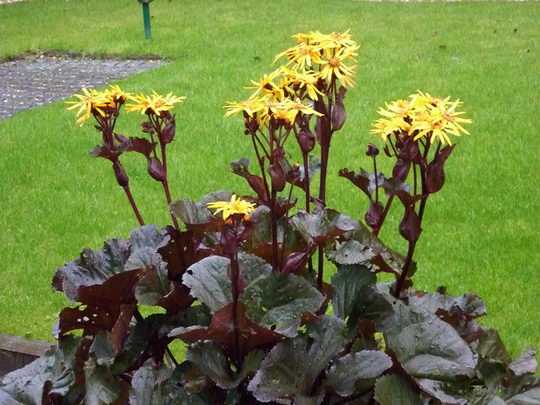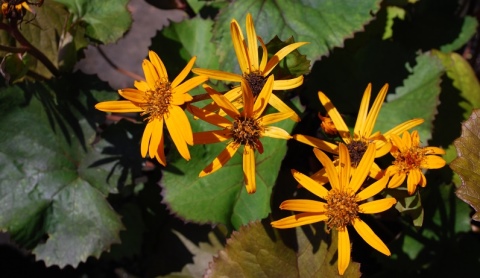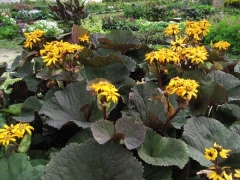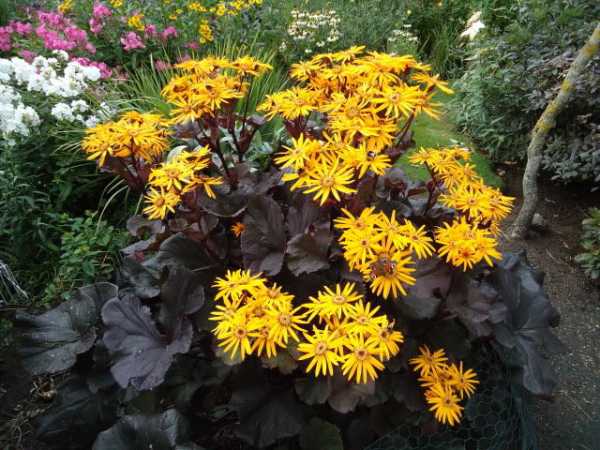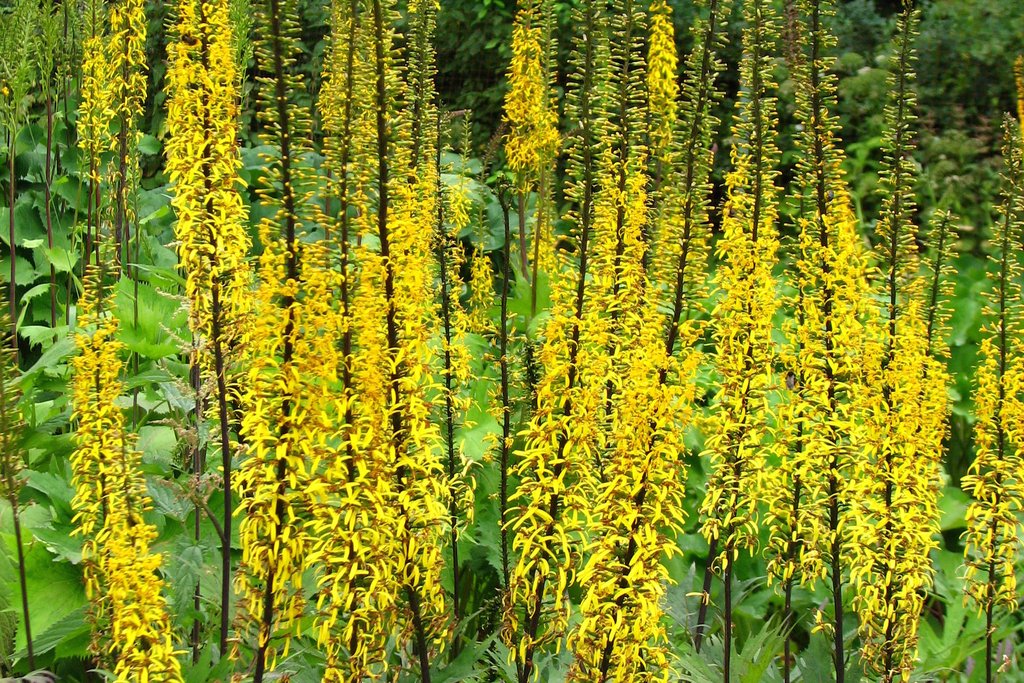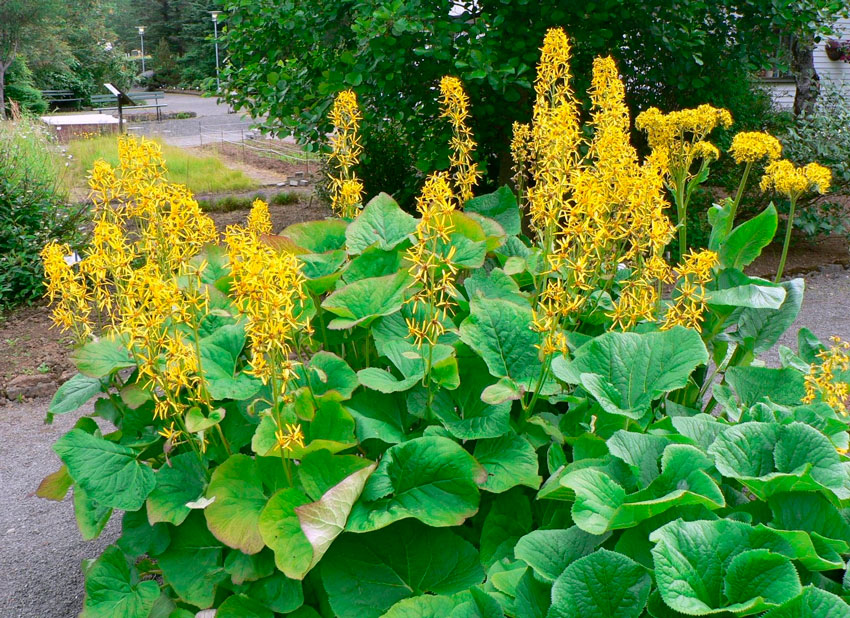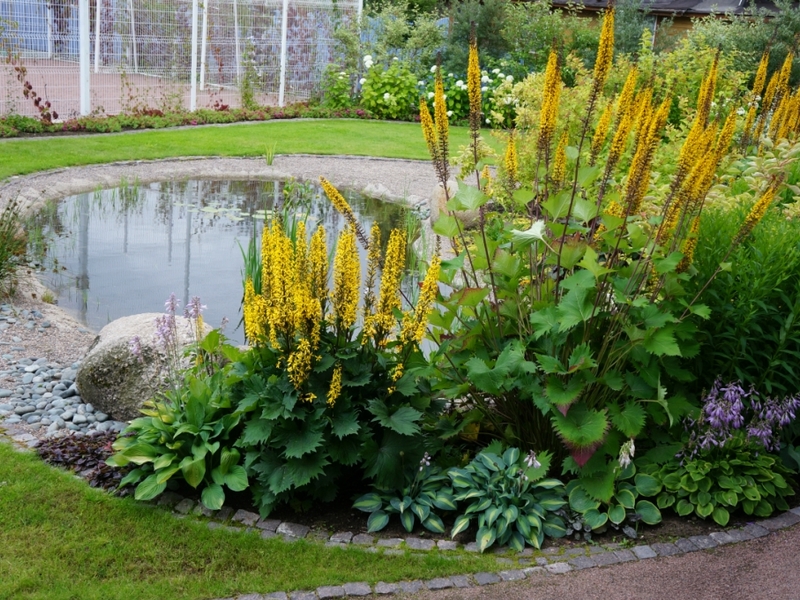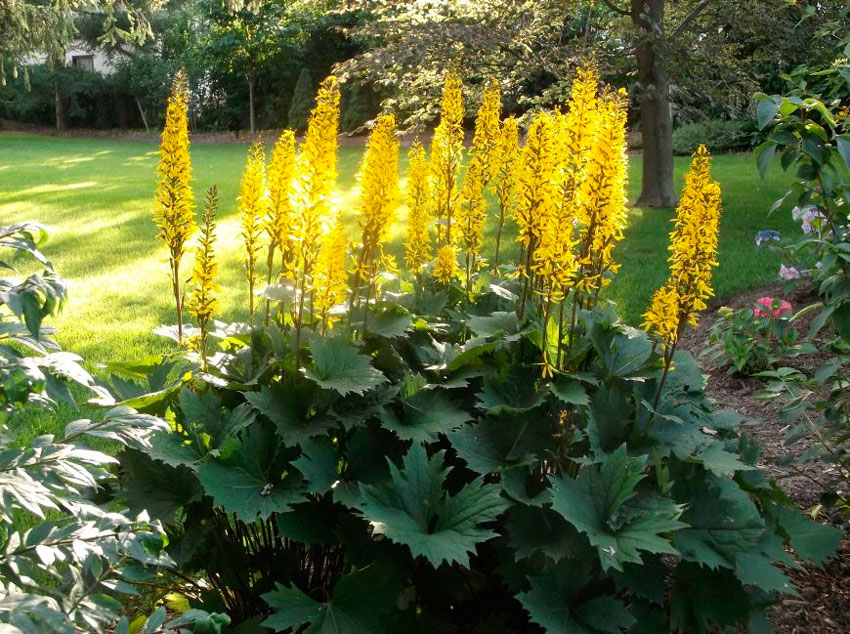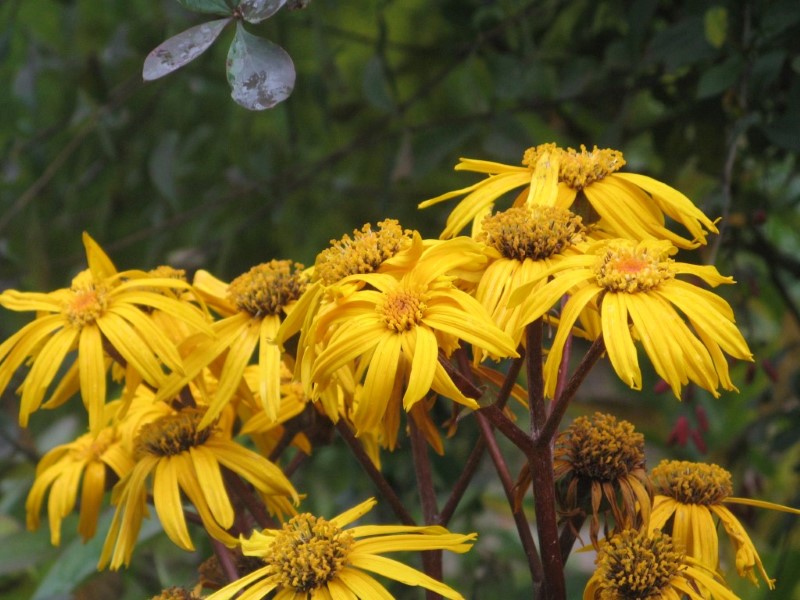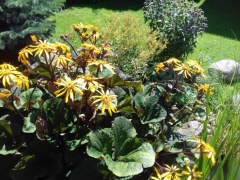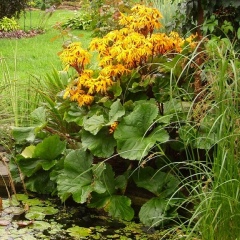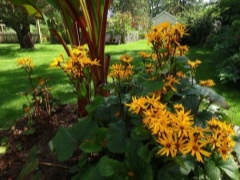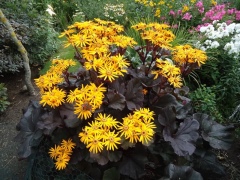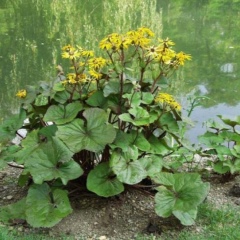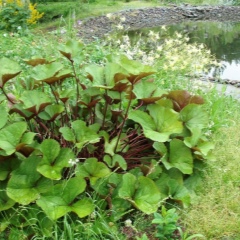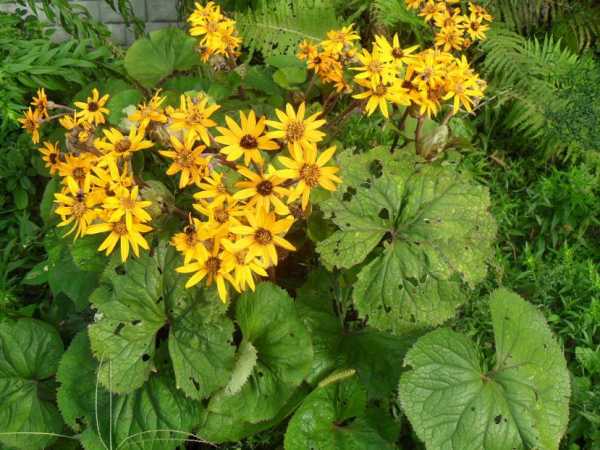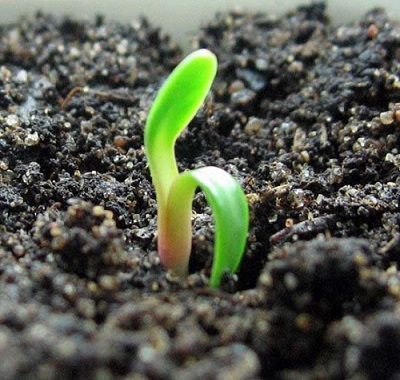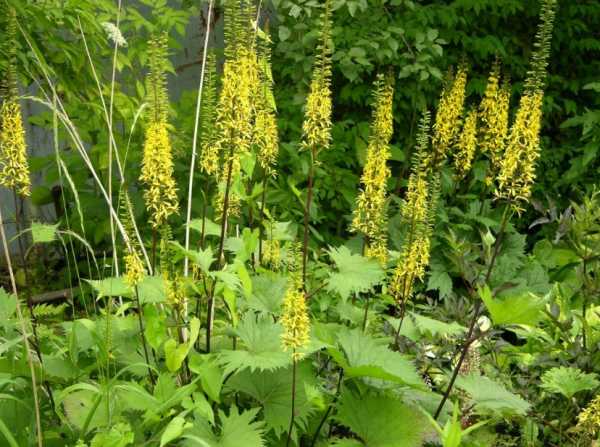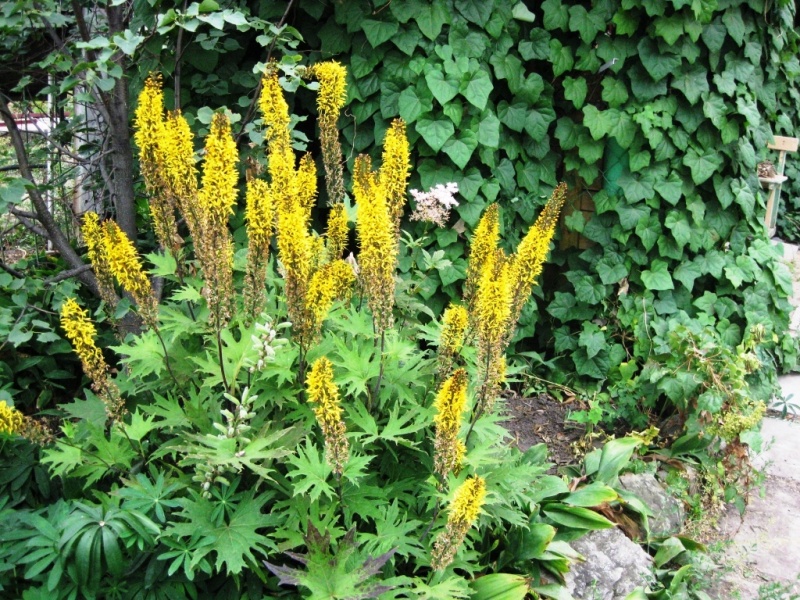Combination with other garden plants
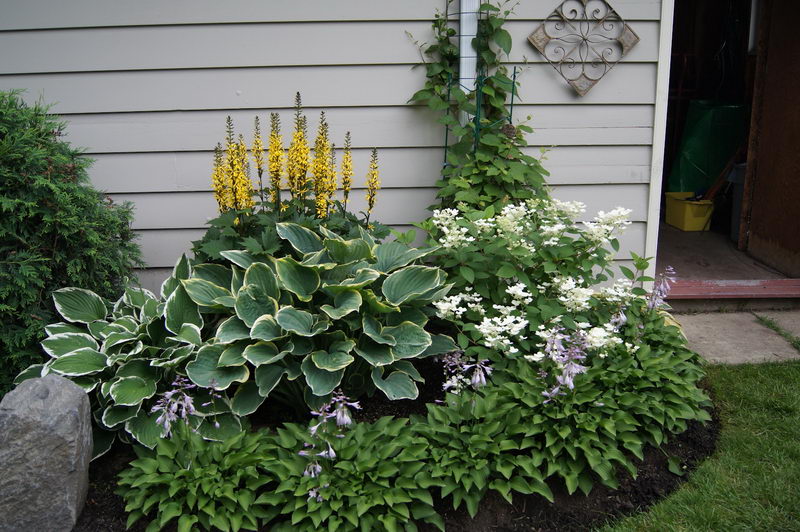
Buzulnik in landscape design in combination with hosts, actinidia and hydrangea Kiwi vine (Actinidia kolomikta ‘Male’) Hydrangea ‘Quick Fire’ Ligularia ’Little Rocket’ Hosta ‘Sagae’ Hosta ’Patriot’ Hosta
A beautiful spring composition can be created by a neighborhood with a primrose. It is also recommended to plant a delphinium nearby, in the colors of which there are blue, white, pink, and this looks very colorful next to yellow ligularia. Later, the blue note can be picked up by violet-blue aconites. First of all, plants with similar growing conditions should be placed nearby.

Buzulniki in landscape design photo mixborder
There are compositions, the participants of which are:
- astilba;
- host;
- lungwort;
- badan;
- rudbeckia;
- rogersia;
- mountain woman;
- lilies.
When choosing neighbors for a buzulnik, especially perennial plants, do not forget about the dimensions of the ligularia. Large varieties in adulthood occupy an area under the foliage of about a square meter, so they can easily "drown out" neighbors planted too closely.
Examples of using buzulnik in the landscape:
- tall, ceremonial ligularia are very good in single landings, and they attract the eye;
- you can arrange a whole barrage of buzulniks, hiding behind it, for example, a fence;
- Ligularia look good, like the lower tier in an orchard, diluting greens with bright colors;
- also, can create a lower step in front of a row of tall bushes;
- on the contrary, the buzulnik will not be lost in the background of the mixborder;
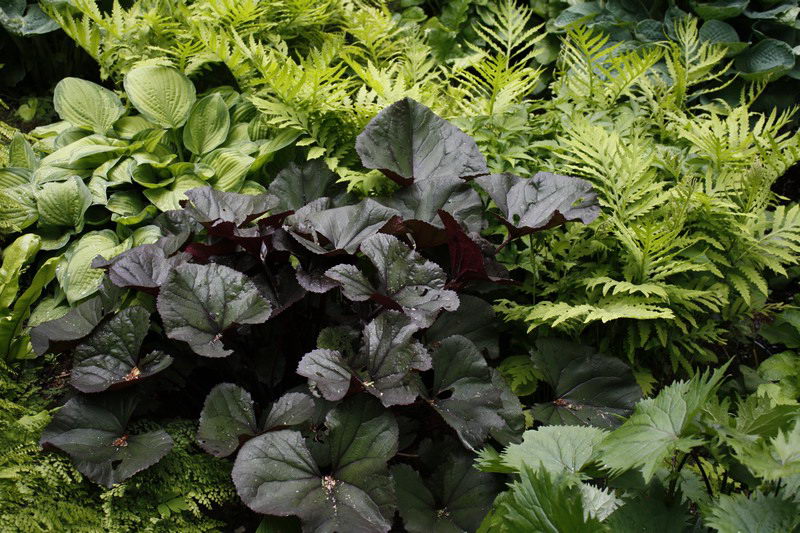
Buzulnik in combination with hosts and fern photo
- you can create a stepped composition only from ligularia, using different varieties (just take into account that Tangut Buzulnik grows far from the base of the bush and is capable of ruining the entire composition);
- used to decorate corners in a "wild style";
- can be used to mask compost pits;
- looks perfect next to water (pond, stream);
- taking into account the late flowering period, they are placed with summer plants, which by autumn lose their attractiveness.
Perhaps the buzulnik is not yet fully appreciated by our growers, unlike the English ones. Experiment with this plant and you will be pleasantly surprised by its decorative qualities. Fans of large forms and "front entrances" will especially appreciate it. Lovers of rustic motives will also find a plant to their liking. Good luck in breeding buzulniks!
Varieties and types of buzulnik
There are different types and varieties of buzulnik. Let's consider the most popular ones.
| Variety name | general description | Care features | Scope of application |
| Altai (Altaica) | Low bush with short rhizomes, gray leaves, yellow flowers | It does not require special care | As part of flower beds and flower beds |
| Alpine (Alpigena) | Dwarf bush, gray leaves, yellow flowers | Requires periodic watering | Single landing |
| Shiny (Splendens) | Bush up to 1.5 m long, serrated leaves at the edges, yellow flowers | Prefers shade or partial shade | As a background in mixborders |
| Wilson (Wilsoniana) | Bush up to 1.5 m high, wavy leaves, yellow flowers | Requires abundant watering | In group plantings together with large perennials |
| Vorobiev (Vorobievii) | The height of the bush is up to 2 m, the leaves are dark green, the flowers are yellow | Loves moisture, requires watering | In group and single landings |
| Naryn (Narynensis) | Low bush, rounded leaves, yellow flowers | Requires feeding several times during the season | In parks and gardens, in folk medicine |
| Przewalskii | Plant height - up to 1.5 m, dull leaves, yellow flowers; one of the most common types | Unpretentious plant, care is simple | In ornamental gardening |
| Serrated (Dentata) | The height of the bush is up to 1.8 m, the leaves are light green, the flowers are yellow or brownish, a common type | Requires abundant watering | As a tapeworm and as part of groups |
| Kempferi | Bush height - up to 0.5 m, green leaves, yellow flowers | Prefers clay soils, no careful maintenance required | In compositions with rudbeckia and daylilies |
| Chinese (Chinensiana) | Plant height - up to 0.5 m, leaves are cut almost to the middle, green | Loves moisture, especially during dry periods | In flower beds |
| Large-leaved (Macrophylla) | Bush height - 1.5 m, elliptical leaves, gray-gray, yellow flowers | Unpretentious plant, does not require careful maintenance | Single planting and on the lawn |
| Narrow-headed (Stenocephala). | The height of the bush is 1.5 m, the edges of the leaves are serrated, the inflorescences are racemose | Requires feeding several times per season | Can be planted in mixborders as an accent |
| Fischer | Bush up to 1.5 m high, short roots, yellow flowers | Unpretentious appearance, practically does not require maintenance | Looks organically on the shore of the pond |
| Hodgesonii | Dwarf bush, height - 0.45 m, rounded leaves, yellow flowers | Unpretentious, winter-hardy look, grows well in the shade, does not require careful maintenance |
Under trees, near bodies of water |
| Japanese (Japonica) | Shrub up to 1.5 m high, orange flowers, palmate-lobed leaves | Unpretentious variety. But it cannot be planted in direct sunlight. | In the background of the flower garden |
| Hybride | Bush up to 1.5 m high, green or red leaves, yellow-brown flowers | Requires as much moisture as possible | As a tapeworm |
| Zepter | Bush up to 1.5 m high, leaves are carved at the edges, yellow flowers | Garter needed | Looks great among greenery |
| Hessei | Leaves are heart-shaped, flowers are collected in a corymbose inflorescence | Requires feeding as humus | In landings with volzhanki and brunners |
| Finger-lobed (Palmatiloba) | Hybrid, height up to 1.8 cm, rounded leaves, yellow flowers | Undemanding appearance | Together with primrose and tulips |
| Otello | Bush height - 0.9 m, purple leaves, orange flowers | Requires 1-2 feeding with organic substances | For decorating ponds and hedges |
| Desdemona | Possesses lilac leaves; orange flowers, stem height - 1 meter | Poor soils require mineral fertilizing | On the lawn or flower bed |
| Osiris Fantasy | Dwarf bush - up to 0.5 m, the leaves are burgundy on top, dark green below | Periodic watering is required | As a background for a flower garden |
| Britt Marie Crawford (Ligularia dentate Britt-Marie Crawford) | Elegant bush with bicolor leaves, yellow or orange flowers | Requires abundant watering in spring and summer, demanding light |
Near reservoirs of various types |
| Rocket (Stenocephala Rocket) | Powerful tall variety, large leaves, yellow flowers | Virtually no maintenance requirements. Shelter is needed for the winter | Single landing |
Description of the plant buzulnik
The name of the plant comes from the Latin Ligularia (ligularia), which means "tongue". She was so nicknamed because of the shape of the flowers, which are located high above the leaves.
The rosette is made up of large, luxurious green leaves, placed one after another. There are leaves with a shade of bronze, purple and even purple. Sometimes small specks may be present on the leaves. The variety of the plant determines the shape and size of the leaf. The size can vary from 30 to 80 cm.
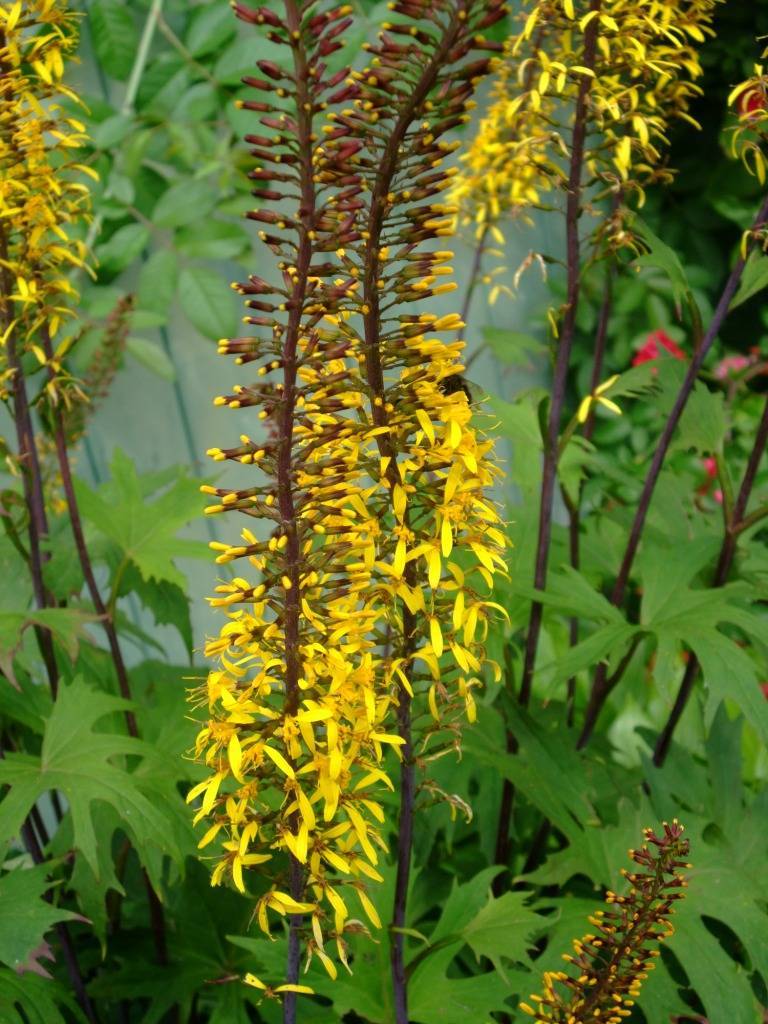
Buzulnik flower
Orange-yellow flower stalks are located high above the foliage. They are bare and have inflorescences in the form of an ear, brushes, and a shield. Buzulnik inflorescences reach 10 cm in width. Flowers are tubular and ligulate. The first to bloom are the buds located closer to the outlet. Flowering starts at the beginning summer. Gradually, the inflorescences located above begin to bloom. And this continues until mid-autumn.
Buzulnik plant looks powerful and sturdy.This is facilitated by a strong, developed root system. It has many branches and reaches half a meter in length. When the buzulnik fades, the corydalis seeds ripen.
Planting a buzulnik
Sowing seeds
Buzulnik can be propagated by dividing the bush and seeds. Seeds are sown in the spring in open ground, while they are buried only 1 centimeter. Before seedlings appear, it is necessary to ensure that the soil is always moist. Seemed seedlings must be shaded from direct sunlight from lunch to evening. However, it is recommended to sow in November or December before winter, and use recently collected seeds for this, during the winter they will be able to undergo natural stratification. For seedlings, seeds are sown in January or March (depending on the flowering time of the variety or species), they are transplanted into open soil in May, when there is no threat of frost. In the event that the seeds have time to ripen directly on the bush and fall on the soil surface, then self-seeding occurs. A plant grown from a seed begins to bloom only at the age of 4 or 5 years.
Transplanting and dividing the buzulnik bush
In the same place, this plant can grow for about 20 years. However, once every 5 years, the bush must be dug up, divided and transplanted, since the root system grows strongly and protrudes from under the soil. The best time for transplanting is spring, at the beginning of the growing season, at a time when young leaf plates are just beginning to grow, since it is at this time that the delenki will take root faster and best. The whole bush should not be dug out of the ground, you need to cut off the necessary part with a shovel and dig only it. The resulting hole must be filled with soil saturated with nutrients, then water the remaining bush. The dug out part of the plant must be thoroughly rinsed, and then, using a very sharp knife, divide it into divisions. At the same time, at least one viable kidney must be present on each section. Places of cuts must be treated with crushed charcoal or potassium manganese solution. The planting hole should be 40x40 centimeters in size, while the distance between plants should be from 100 to 150 centimeters. Pour 1.5 buckets of humus into the hole before planting, as well as a small amount of superphosphate and wood ash. Correctly planted divisions for the next year already become very beautiful.
Emergency landing
In the event that you are going to plant a flowering plant during the summer, then the bush must be prepared. To do this, you need to remove the peduncle and cut off 1/3 of the leaves, while you need to start from the lower leaf plates. It should be planted in the same way as the delenki (see above). The bush should be protected from direct sunlight, and also make sure that the soil is moist all the time. Since you will be replanting the buzulnik in the summer, a large amount of strength will be required from it until it takes root. After about 4 weeks, it should completely take root.
How to care for a buzulnik
The most important thing is to figure out what we want from the plant. If we just planted "to grow", then let it grow, the buzulnik is unpretentious
If the goal is to reveal 100% of its decorative effect, to show it "in all its glory", then let's pay attention to three whales:
- humidity;
- illumination;
- top dressing.
Soil moisture is maintained naturally by watering, loosening and mulching. All buzulniks love moist soil, watering should be done regularly, once a week, abundantly. In dry summer, more often twice a week. Yes, this is understandable, because through such huge leaves, evaporation in the heat is very intense.

Buzulnik in a mixborder variety Ligularia dentata ‘Britt-Marie Crawford’ composition photo
Of course, after watering, it is advisable to loosen the soil, weeds will be automatically removed, the crust will break.To repeat this process less often, we mulch the soil with peat or humus. If there is no rain for a long time during the season, then not only the soil becomes dry, but also the air. To moisturize, turn on the sprayer in the evening or early in the morning for half an hour. By the way, in such weather the leaves of the ligularia can wither and hang with "rags", but they straighten out again at night.
As for lighting, let us pay attention once again - ligularia reveals its maximum decorative effect in partial shade or shade. In the sun, an interesting spot on the leaves disappears, various shades of flowers are lost, the leaves curl up, the plant does not develop well
But in every garden there is a very shaded corner that you want to decorate. The answer on the surface is to plant a buzulnik there and he will illuminate it with his torch flowers.
Top dressing can help the buzulnik maintain their decorative effect
- We have already completed the first one during landing. Before flowering, add a mullein solution under each plant at the rate of 1:10.
- For feeding ligularia, choose a warm time so that not only the days, but also the nights are warm. Otherwise, it will give the opposite effect - the decorative effect of the bush will suffer.
- Before the onset of autumn, all top dressing must be completed so that the plant has time to prepare for winter.
If you do not have natural fertilizers, then complex mineral fertilizers diluted according to the instructions are also suitable.
The above rules of care are ingenuous and accessible to any novice gardener.
Buzulnik will become your favorite. You will carefully tie up the mighty flower stalks if they need it. Most likely, the seeds will not be needed, so periodically remove the faded peduncles so that the ligularia has a neat appearance, wasting its energy on continuing to bloom. If this is not done, then the flowers become smaller, wither, thin out.


